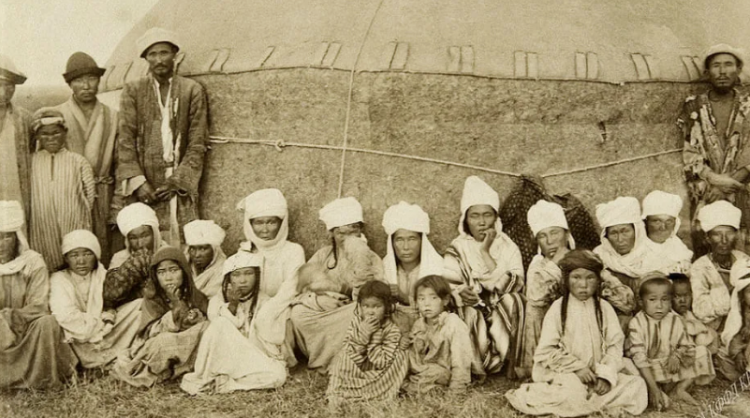
Epitaph in Honor of Bars-Beg This gravestone runic inscription in honor of the Kyrgyz khan...

THE FOOLISH KHAN In ancient times, there lived a rich khan. He had plenty of livestock, but not...

Monument to Kagan Mogilyan (Bilge. 716—734 AD) The monument to this kagan of the Eastern Turkic...

The Fourth Talas Monument In the summer of 1982, on Lenin Street (formerly Zhany-Chek) at the 1st...

Bag of Gold Once, three travelers met on the road. When they started talking, it turned out that...

Exhibition Hall of the Union of Artists of the Kyrgyz Republic "Oak Park" named after...
On November 1, the Kyrgyz police will celebrate its 101st anniversary. In this regard, Turmush...

Large Boulder with Runic Inscriptions In 1962, archaeologist D. F. Vinnik discovered another large...

THE SEVEN SONS OF THE OLD WOMAN Once upon a time, there lived a poor old woman who had seven sons....

The Infiltration of Yenisei Kyrgyz into the Tian Shan Our task is to examine the issues regarding...

Naabat Once upon a time, they say, there lived a khan named Azil. He ruled his people wisely and...

Orkhon-Yenisei Turkic Monuments These runic inscriptions were mainly found in the territory of...
Asiya Zheenchoroeva, who currently heads the ethno-folklore ensemble "Asylzat," dreamed...

Once, Khan Baytik decided to capture Tokmak. Not far from the city, in a gorge, he left his...

Stones from the Village of Yangy-Naukat Near the village of Yangy-Naukat (collective farm...

REPORT NOTE OF THE SCIENTIFIC GARDENER A.M. FETISOV TO THE MILITARY GOVERNOR OF THE SEMIRECHYE...

“HOW SAD...” Once upon a time, there was an old man. Every new day, he greeted with the same...

CHOLPON AND THE TWO HEROES. This happened long ago when the Kyrgyz lived as one tribe among the...

Khan Janibek Once, Khan Janibek summoned the leader of one of the ails, Sultanmamit Khan, and said...

Shirak - a simple sack shepherd who gave his life for the Motherland In ancient times, the Persian...

LETTER FROM ATAKE BATYR TYNAY BI UULU TO THE COMMANDER OF THE SIBERIAN REGIMENTS GENERAL N. T....

Part 3 Kanykey becomes a mother, raising her son. The name of the mother is sacred, her milk is...

"Kokuy-Kul" Among the high mountains lies a small but very deep lake called Kokuy-Kul....

“The Kyrgyz Tribe Named Itself Oghuz-Khan” The clan-tribal structure of the Kyrgyz of the right...

Readiness of Kyrgyzstanis to Defend the Motherland On the very first day of the war, June 22,...

Kaïraks from Sahaba-Mazara In the second issue of "Epigraphy of Kyrgyzstan," we...

Mourning for Khan Koketey in the Karkyra Valley Rich and glorious Koketey, By the will of God and...

The wives of three American presidents wear brooches and necklaces by the famous Kyrgyz...

KHAN KOSHOY In a hilly area crossed by a river, the hero Koshoy gathered the Kyrgyz from seven...

BAYTIK-BATYR In 1862, a rebellion erupted among the Kyrgyz in the Chuy Valley. It was led by the...

JETI-OGUZ...

NOTIFICATION LETTER FROM THE MANAP OF THE SARYBAGYSH TRIBE JANTAY KARABEKOV TO THE...

Chagatai Chagatai declared his grandson Khara-Khulagu, son of Mutugen, as his heir. In 1241,...

Once upon a time, there lived three orphaned brothers. Every day they went to the forest to gather...

The social composition of families was directly dependent on the economic specifics of the family...

The Death of Manas At night, secretly Kanykey Gathered the loyal warriors, Far along the mountain...

The family is the most important institution in the system of social relations in Kyrgyz society....

Burana Monuments MONUMENT NO. 1 Round, disc-shaped, gray stone measuring 30x35 cm. An unusual...

LETTER FROM THE BAILIFF AMONG THE KAZAKHS OF THE SENIOR ZHUZ M.M. KHOMENTOVSKY TO THE SARYBAGYSH...

Once upon a time, there was a khan. One day, he deeply pondered his life and, finding no answers...

The Birth of the Hero Hey! Jakyp, my brother Chiyr Suddenly left for another world. His wife — the...

ZHÉERENCHÉ-CHÉCHEN AND KARACHACH In ancient times, there lived a man named Zhéerenché-chéchen....

The Great Campaign. The Wounding of Manas and the Return of the Kyrgyz to Talas. Part-3 When...
The film tells about the life and work of shepherds in the highlands of Kyrgyzstan and how new...